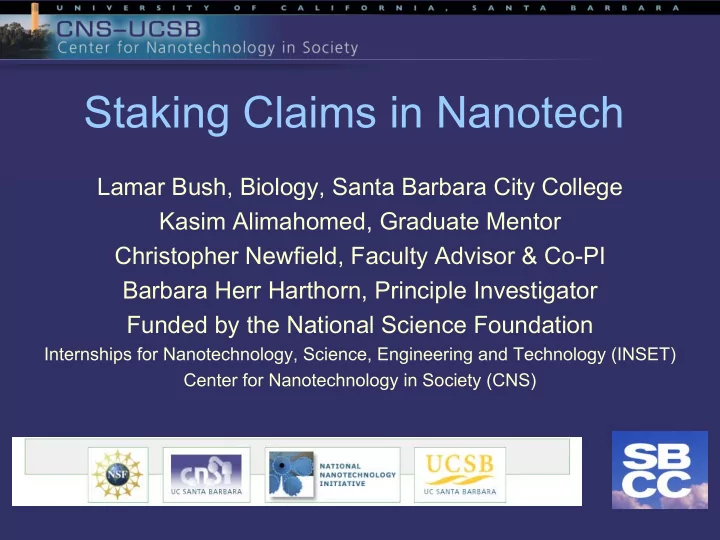

Staking Claims in Nanotech Lamar Bush, Biology, Santa Barbara City College Kasim Alimahomed, Graduate Mentor Christopher Newfield, Faculty Advisor & Co-PI Barbara Herr Harthorn, Principle Investigator Funded by the National Science Foundation Internships for Nanotechnology, Science, Engineering and Technology (INSET) Center for Nanotechnology in Society (CNS)
Our Society is build on the open exchange of information My research group examined: • Who owns the ideas that create nanotechnology • How did the inventors meet • How is that technology transferred to industry
Publish or Perish Scientists present the research to the World. So they can stake their claim to a patent that utilizes their innovation and benefits society.
Who owns Nanotech? By ancient convention innovators can Patent then Publish stake a claim if they: Publish and Patent Produce Publish Patent In 1980 with the passage of the Bayh-Dole Act Universities in the USA gained a stake in the patents from the research they helped conduct and became a player in its commercialization
What are Patents? Patents are government grants of property made to inventors of novel and useful items or processes. Someone first stakes a claim This area is staked by Isaac What if someone else comes along and claims another Move over This stake surveyed patent? by Vern boys this is now all ruled And then a third one by BIG AL. moves into the territory.
Defined Patents must not overlap. by Isaac Unique and How do divvy up separate an atom? Unique and Unique and separate separate Field of Vern’s Big Al’s Electrons are such slippery things: Are the particles or are they waves?
∆ ∆ ∆ ∆ ∆ ∗ ∗ ∗ ∗ ∗ ∆ ∆ ∆ ∆ ∆ ≥ ≥ ≥ ≥ ≥ x x x x x p p p p p h h h h h At nanopatents property lines are… Blurred by uncertainty! BIG AL Isaac Newton Werner Heisenberg F=ma E=mc 2 ∆ x ∆ ρ > h /4π
My part in tracking Intellectual Property I read � Patents � Scientific Papers � Technology Transfer agreements and created abstracts and prepared data to be used in graphing and visualizations. These were designed to reveal � Whom was publishing with who � Whom was patenting with who � Whom was selling processes to who
Quantum Dots Patent Filings Quantum Dot patents filed up to 070514 according to SciFinder Scholar 400 quantum dot quantum dots 350 300 Number of filings 250 200 150 100 50 0 9 1 2 3 4 5 6 7 8 9 0 1 2 3 4 5 6 7 8 9 9 9 9 9 9 9 9 9 0 0 0 0 0 0 0 0 9 9 9 9 9 9 9 9 9 9 0 0 0 0 0 0 0 0 1 1 1 1 1 1 1 1 1 1 2 2 2 2 2 2 2 2 Year
Various Patent categories with Entangled Intellectual Property Dendrimers Fullerenes Carbon Quantum Nanowires Nanotubes Dots General 50% 50% 75% 95% 25% Structural 50% 75% 50% 5% 0 Energy 50% 25% 50% 50% 5% Optics 50% 25% 50% 50% 50% Electronics 50% 75% 25% 50% 50% Healthcare 50% 25% 75% 75% 5% Source: Luxresearch used with permission- values are approximate
Connectedness of patent inventers who filed with Evelyn Hu and each other
Water-soluble Semiconductor Nanocyrstals Conflict � Two companies Nanosys and Quantum Dot Corporation claim to hold all licenses on all Patents on Quantum Dots. � QDC claims all biological applications and Nanosys claims everything else. � Yet, Evident Technologies markets proprietary water- soluble semiconductor nanocrystals for biomolecule detection and maintains that they are not infringing on QDC’s patents. As of July 2007 this situation has not been resolved.
Further Research • Will a Patent Thicket logjam the river of commerce? • Can Government remain Neutral? • Will scientists stop sharing their research? • Will the Patent offices around the World stop issuing contradictory patents?
Observations Our 500 years old system of Patenting is stressed: • Legally • The Laws of Physics burr • Inventors are holding by their discoveries Governments, once neutral referees, are now indirect players in industry through: Universities & Industrial Research Tax Breaks
Speculation To keep the system going innovators: • Must be able to get credit and recognition for their discoveries • Must be satisfied that they are being fairly compensated for their work • Likewise authority must be fair to the consumers, the workers and manufacturers as well as the innovators
Acknowledgements Sincere Gratitude to: Kasim Alimahomed, Graduate Mentor Emily Kang, CNS Coordinator Samantha Freeman, INSET Coordinator Nick Arnold, Professor of Engineering Barbara Herr Harthorn, Principle Investigator for CNS Fiona Goodchild, INSET Education Director Liu-Yen Kramer, INSET Co-Education Director Evelyn Hu, CNSI Co-director Luke Bawazer, Supermentor Christopher Newfield, Faculty Advisor & Co-PI And the staffs of INSET, CNS and CNSI
Questions ?
JPEG Patent law suit In 1997 a company named Forgent acquired another called � Compression Labs. In 2002 when Forgent was reorganizing and laying off people consultants were hired to evaluate its assets. They discovered US patent number 4,698,672 that was owned by Compression. This patent was applied for in 1986 and dealt image compression. Forgent then sued Microsoft, IBM, Sony etc. claiming damages on up to one Billions Dollars. JPEG (Joint Photographic Experts Group) was a standard � convention agreed to for common use. In 2006 the lawsuit was finally settled for $8 million after � Sony and others paid had paid $2 million previously. The US PTO had agreed to review the patent in Feb. 2007. Forgent’s legal bills were citied in their agreement to settle.
Points � Only 2% of Patent pay for themselves. � The cost of worldwide Patents rights can run to $250,000 per patent. � Patent Troll-an individual or group that acquire intellectually property rights solely to cause trouble for those that want to commercialize intellectual property. � Patent Thicket-A legal morass the prevents patents from being viable.
Recommend
More recommend